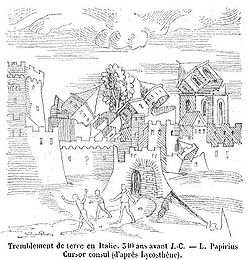
Conrad Lycosthenes
Encyclopedia

Renaissance humanism
Renaissance humanism was an activity of cultural and educational reform engaged by scholars, writers, and civic leaders who are today known as Renaissance humanists. It developed during the fourteenth and the beginning of the fifteenth centuries, and was a response to the challenge of Mediæval...
and encyclopedist.
Life
He was born in RouffachRouffach
Rouffach is a commune in the Haut-Rhin department in Alsace in north-eastern France.Rouffach lies along the Alsatian wine route ....
in Alsace
Alsace
Alsace is the fifth-smallest of the 27 regions of France in land area , and the smallest in metropolitan France. It is also the seventh-most densely populated region in France and third most densely populated region in metropolitan France, with ca. 220 inhabitants per km²...
on August 8, 1518, the son of Theobald Wolffhart and Elizabeth Kürsner, sister of the Protestant theologian Conrad Pellicanus
Conrad Pellicanus
Konrad Pellikan was a German Protestant theologian, humanist, and Christian Hebraist who worked chiefly in Switzerland.-Life:His German name, "Kurscherer", was changed to "Pellicanus" by his mother's brother Jodocus Gallus, an ecclesiastic...
. He later changed his German name, Wolffhart, to the humanist name Lycosthenes.
From 1535 to 1539, Conrad studied philosophy
Philosophy
Philosophy is the study of general and fundamental problems, such as those connected with existence, knowledge, values, reason, mind, and language. Philosophy is distinguished from other ways of addressing such problems by its critical, generally systematic approach and its reliance on rational...
in Heidelberg
Heidelberg
-Early history:Between 600,000 and 200,000 years ago, "Heidelberg Man" died at nearby Mauer. His jaw bone was discovered in 1907; with scientific dating, his remains were determined to be the earliest evidence of human life in Europe. In the 5th century BC, a Celtic fortress of refuge and place of...
. In 1542, he left Heidelberg for Basel
Basel
Basel or Basle In the national languages of Switzerland the city is also known as Bâle , Basilea and Basilea is Switzerland's third most populous city with about 166,000 inhabitants. Located where the Swiss, French and German borders meet, Basel also has suburbs in France and Germany...
where he began teaching Grammar and Dialectics. In 1545, at the age of 27, he became Deacon in the Church of Saint-Leonard. On December 21, 1554, he suffered from hemiplegia
Hemiplegia
Hemiplegia /he.mə.pliː.dʒiə/ is total paralysis of the arm, leg, and trunk on the same side of the body. Hemiplegia is more severe than hemiparesis, wherein one half of the body has less marked weakness....
and lost the ability to use his right hand. He learned to write with his left hand and continued his literary works until his death from apoplexia on March 25, 1561, at the age of 43. In the meantime he had married Chretienne Herbster, sister of the famous Basel book printer Johannes Oporinus
Johannes Oporinus
Johannes Oporinus was a humanist printer in Basel, the son of the painter Hans Herbst- Life :...
(Oporin) and widow of Leonard Zwinger, father of Theodor Zwinger
Theodor Zwinger
Theodor Zwinger the Elder was a Swiss physician and humanist scholar. He made significant contributions to the emerging genres of reference and travel literature...
, author of the Theatrum vitae humanae.,
Works

- 1547 Commentaries on De viris illustribus, Basel, in-8°.
- 1551 Elenchus scriptorum omnium, Basel, in-4°.
- 1551 Gnomologia ex AEneae Sylvii operibus collecta, Basel, edit.1555, in 4°.
- 1552 Iulii Obsequentis Prodigiorum liber, ab urbe condita usque ad Augustum Caesarem, cujus tantum extabat Fragmentum, nunc demum Historiarum beneficio, per Conradum Lycosthenem Rubeaquensem, integrati suae restitutus. Basilae, ex off. Ioannis Oporinii, Anno Salutis humanae, M.D.LII. Mense Martio, in-8°.
- 1552 J. Ravisii Textoris officina, Basel.
- 1555 Apophthegmatum sive responsorum memorabilium, ex probatissimis quibusque tam graecis quam latinis auctoribus priscis pariter atque recentioribus, collectorum Loci communes ad ordinem alphabeticum redacti, Basel, in fol.
- 1557 Epitome Stobaei Sententiarum, Basel, in -8°.
- 1557 Parabolae sive similitudines ex var. auct. ab Erasmo collectae, in locos communes redactae, Berne in-4°; Basel, 1575, 1602, in-8°.
- 1557 Prodigiorum ac ostentorum chronicon, quae praeter naturae ordinem, et in superioribus et his inferioribus mundi regionibus, ab exordio mundi usque ad haec nostra tempora acciderunt. Basileae per H. Petri, fol, 672 p. fig. et pl. (64).
- 1559 Dom. Brusonii Facetiarum lib. VII, Basel, in-4°.
- 1560 Regula investigationis omnium locorum in tabula Helvetiae contentorum, Basel, in-4°.
Literature
- Lucio D. Brusoni, An extracte of examples, apothegmes, and histories Collected out of Lycosthenes, Brusonius and others, London 1572
- Jürgen Beyer, 'Lycosthenes, Conrad', in Enzyklopädie des Märchens. Handwörterbuch zur historischen und vergleichenden Erzählforschung, vol. 8 (Berlin & New York: Walter de Gruyter, 1994-96), coll. 1323-6

